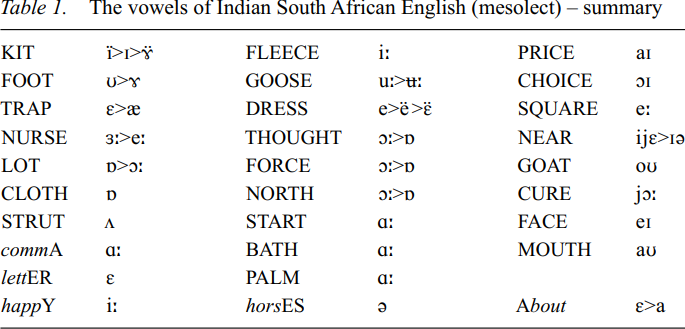


 Grammar
Grammar
 Tenses
Tenses
 Present
Present
 Past
Past
 Future
Future
 Parts Of Speech
Parts Of Speech
 Nouns
Nouns
 Verbs
Verbs
 Adverbs
Adverbs
 Adjectives
Adjectives
 Pronouns
Pronouns
 Pre Position
Pre Position
 Preposition by function
Preposition by function 
 Preposition by construction
Preposition by construction
 Conjunctions
Conjunctions
 Interjections
Interjections
 Grammar Rules
Grammar Rules
 Linguistics
Linguistics
 Semantics
Semantics
 Pragmatics
Pragmatics
 Reading Comprehension
Reading Comprehension|
Read More
Date: 2025-02-27
Date: 2025-03-11
Date: 2023-11-22
|
InSAfE has been studied mostly as a contact variety that involves a great deal of syntactic variation. If less attention has been paid to its phonetics, it has to do with the paucity of researchers working on the accents of varieties of South African English (SAfE) rather than any intrinsic qualities of InSAfE phonetics. On the contrary, InSAfE holds the promise of subtle variations along the following dimensions:
(a) Five substrate languages belonging to two distinct language families: Dravidian (Tamil, Telugu) and Indo-European (Bhojpuri-Hindi, Gujarati, Urdu, Konkani and Sindhi/Meman dialect);
(b) Links with IndE (the English of India);
(c) Links with South African varieties of English, especially varieties spoken in KwaZulu-Natal;
(d) Emergence of a core InSAfE phonology as younger speakers lose contact with the languages of their grandparents’ generation;
(e) Ongoing acculturation amongst middle-class speakers to “General” and “Cultivated” varieties of SAfE as the rigid barriers between young people of different backgrounds weaken, especially in the post-apartheid schoolgrounds;
(f) Regional variation within InSAfE, involving the main dialect in KwaZulu-Natal and smaller pockets in other provinces – Gauteng, Eastern Cape and Western Cape.
The description below is based on my analysis of tape recordings carried out in the mid-1980s, reported in Mesthrie (1992: 34-43) for fieldwork, (1992:136-141) for phonetics. These have been supplemented by more recent recordings in the late 1990s and early 2000s. In addition I rely on earlier discussions by Bailey (c 1985, unpublished notes), Naidoo (1971) and Bughwan (1970).

|
|
|
|
دخلت غرفة فنسيت ماذا تريد من داخلها.. خبير يفسر الحالة
|
|
|
|
|
|
|
ثورة طبية.. ابتكار أصغر جهاز لتنظيم ضربات القلب في العالم
|
|
|
|
|
|
|
سماحة السيد الصافي يؤكد ضرورة تعريف المجتمعات بأهمية مبادئ أهل البيت (عليهم السلام) في إيجاد حلول للمشاكل الاجتماعية
|
|
|